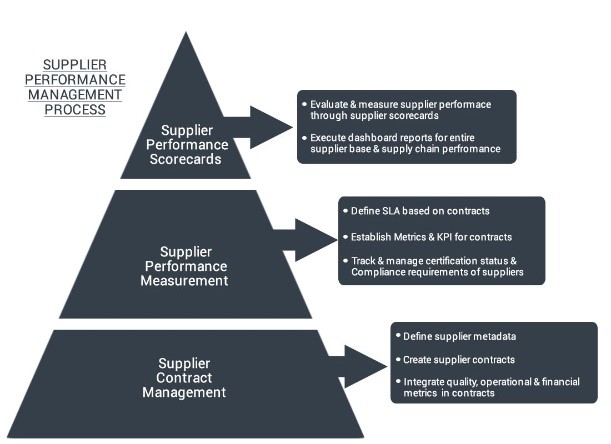
Supplier Performance Management (SPM) Lifecycle and Process:
Our effective method for optimizing supply chains involves a six-phase Supplier Performance Management (SPM) lifecycle, along with the necessary processes and tasks to ensure compliance with flow-down requirements. This approach enables us to assist both customers and suppliers in delivering quality products on time.
1. Supplier Selection
• Task: Evaluate and select suppliers based on capability, quality systems, and
past performance.
• Tools: Supplier audits, RFQs, and vendor evaluation scorecards.
• Goal: Ensure suppliers meet initial qualifications and align with customer
requirements.
2. Supplier Onboarding
• Task: Formalize agreements, share flow-down requirements, and establish
communication protocols.
• Tools: Contracts, supplier manuals, and compliance checklists.
• Goal: Align supplier processes with compliance and quality standards.
3. Performance Monitoring
• Task: Continuously track supplier performance metrics, including delivery
times, quality, and cost.
• Tools: KPIs, dashboards, and periodic scorecards.
• Goal: Ensure ongoing alignment with performance and compliance expectations.
4. Feedback and Improvement
• Task: Provide suppliers with regular feedback and request corrective actions
for performance gaps.
• Tools: Performance reviews, root cause analysis, and corrective action plans
(CAPAs).
• Goal: Foster continuous improvement and stronger supplier relationships.
5. Risk Management and Mitigation
• Task: Identify risks, monitor potential disruptions, and develop contingency
plans.
• Tools: Risk assessments, dual sourcing, and supply chain mapping.
• Goal: Minimize the impact of supplier-related risks on overall operations.
6. Supplier Phase-Out (if necessary)
• Task: Gradually disengage with underperforming suppliers while ensuring
smooth transitions.
• Tools: Transition plans and detailed handoffs.
• Goal: Protect supply chain continuity and maintain compliance.
SPM Process
1. Define Requirements
• Communicate customer flow-down requirements (e.g., regulatory, quality, and
technical standards).
• Document expectations in agreements and supplier manuals.
2. Set Performance Metrics
• Establish measurable KPIs: on-time delivery (OTD), defect rates, and cost
variances.
• Align metrics with customer needs and contractual obligations.
3. Conduct Supplier Audits
• Perform regular audits to verify adherence to requirements.
• Address non-conformances through corrective actions.
4. Monitor and Analyze Data
• Use real-time tracking systems to measure supplier performance.
• Analyze trends to identify improvement opportunities.
5. Drive Continuous Improvement
• Engage suppliers in collaborative problem-solving.
• Share best practices and provide training resources.
6. Ensure Compliance with Flow-Down Requirements
• Track adherence to customer-specific flow-downs (e.g., technical specs, legal
requirements).
• Verify traceability and documentation accuracy throughout the supply chain.
Tasks to Ensure Compliance with Flow-Down Requirements
• Communicate Clearly: Provide suppliers with detailed flow-down requirements.
• Implement Robust Contracts: Ensure agreements include clauses for compliance
and audits.
• Trace Documentation: Maintain a record of compliance evidence at each stage
of production.
• Audit Regularly: Conduct compliance-focused audits to verify adherence to
flow-downs.
• Train Suppliers: Offer training programs to ensure understanding of flow-down
obligations.
• Monitor Supplier Sub-Tiers: Extend compliance checks to sub-tier suppliers to
prevent weak links.
By effectively managing the SPM lifecycle and ensuring compliance with
flow-down requirements, organizations create a reliable supply chain that
consistently delivers quality products on time while meeting customer and
regulatory expectations.
